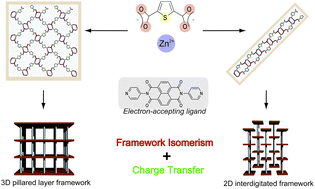 In this HOT article, Kitagawa and co-workers describe two isomorphic frameworks, [Zn(thdc)(dpNDI)]n, based on 2,5-thiophenedicarboxylate (thdc) as the topology-directing ligand, assembled from zinc ions and N,N‘-di(4-pyridyl)-1,4,5,8-naphthalenediimide (dpNDI) as the electron-accepting ligand. The unique connecting angle of thdc promotes the formation of either a 3D pillared-layer framework or an interdigitated 2D layer framework, which are originally synthesized with terephthalic acid or isophthalic acid, respectively. In addition, these isomers show different charge-transfer interactions with electron-donating aromatic molecules because of their intrinsic porous structure determined by their topology. Such a topological design of PCPs can be used in guest-selective sensor materials.
In this HOT article, Kitagawa and co-workers describe two isomorphic frameworks, [Zn(thdc)(dpNDI)]n, based on 2,5-thiophenedicarboxylate (thdc) as the topology-directing ligand, assembled from zinc ions and N,N‘-di(4-pyridyl)-1,4,5,8-naphthalenediimide (dpNDI) as the electron-accepting ligand. The unique connecting angle of thdc promotes the formation of either a 3D pillared-layer framework or an interdigitated 2D layer framework, which are originally synthesized with terephthalic acid or isophthalic acid, respectively. In addition, these isomers show different charge-transfer interactions with electron-donating aromatic molecules because of their intrinsic porous structure determined by their topology. Such a topological design of PCPs can be used in guest-selective sensor materials.
Read more for FREE until 12th May 2011 here:
Control of the charge-transfer interaction between a flexible porous coordination host and aromatic guests by framework isomerism
Yohei Takashima, Shuhei Furukawa and Susumu Kitagawa
CrystEngComm, 2011, Advance Article
DOI: 10.1039/C1CE05201B
See also the tutorial review on coordination polymers by Kitagawa:
Dynamic porous properties of coordination polymers inspired by hydrogen bonds
Susumu Kitagawa and Kazuhiro Uemura
Chem. Soc. Rev., 2005, 34, 109-119
DOI:10.1039/B313997M











